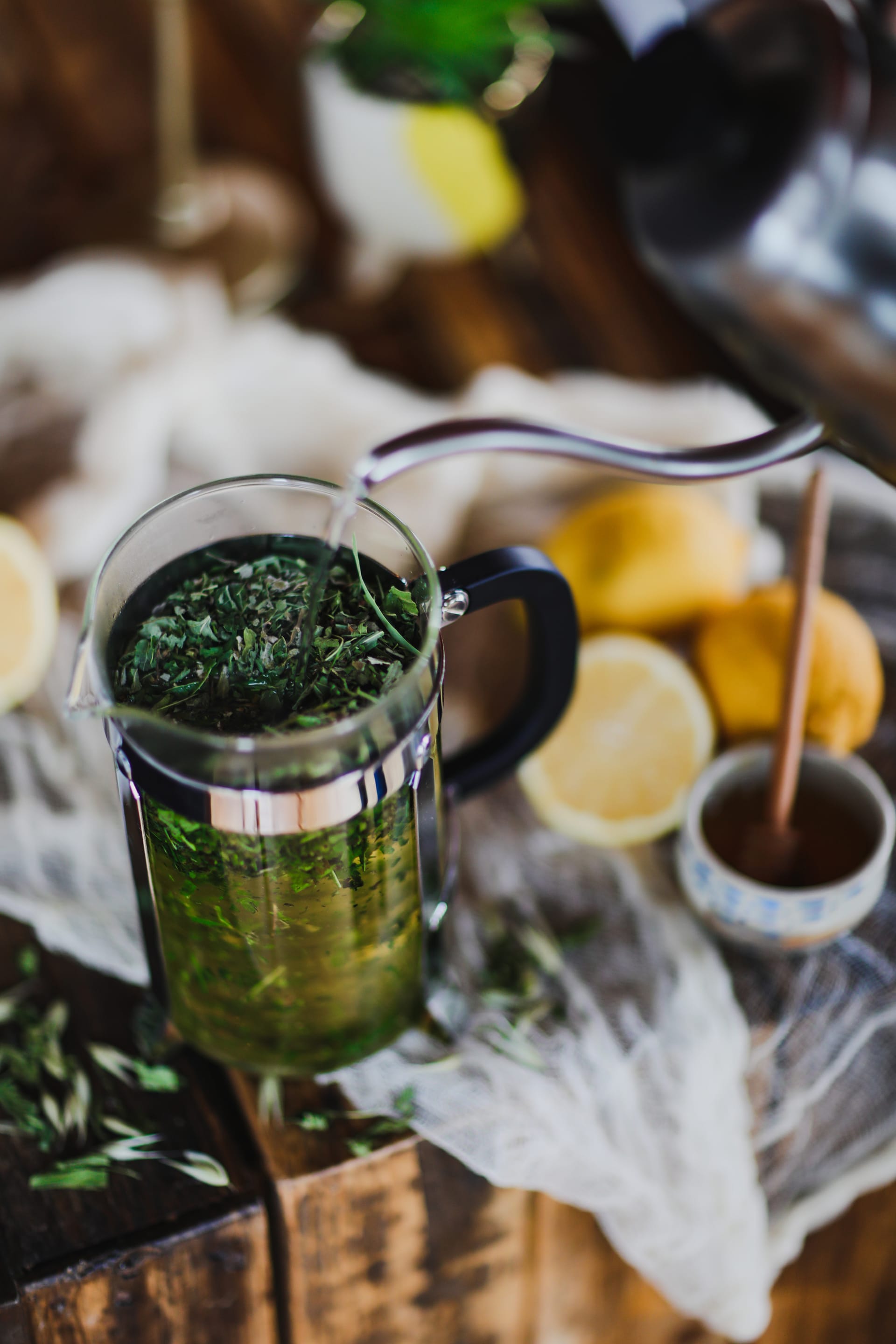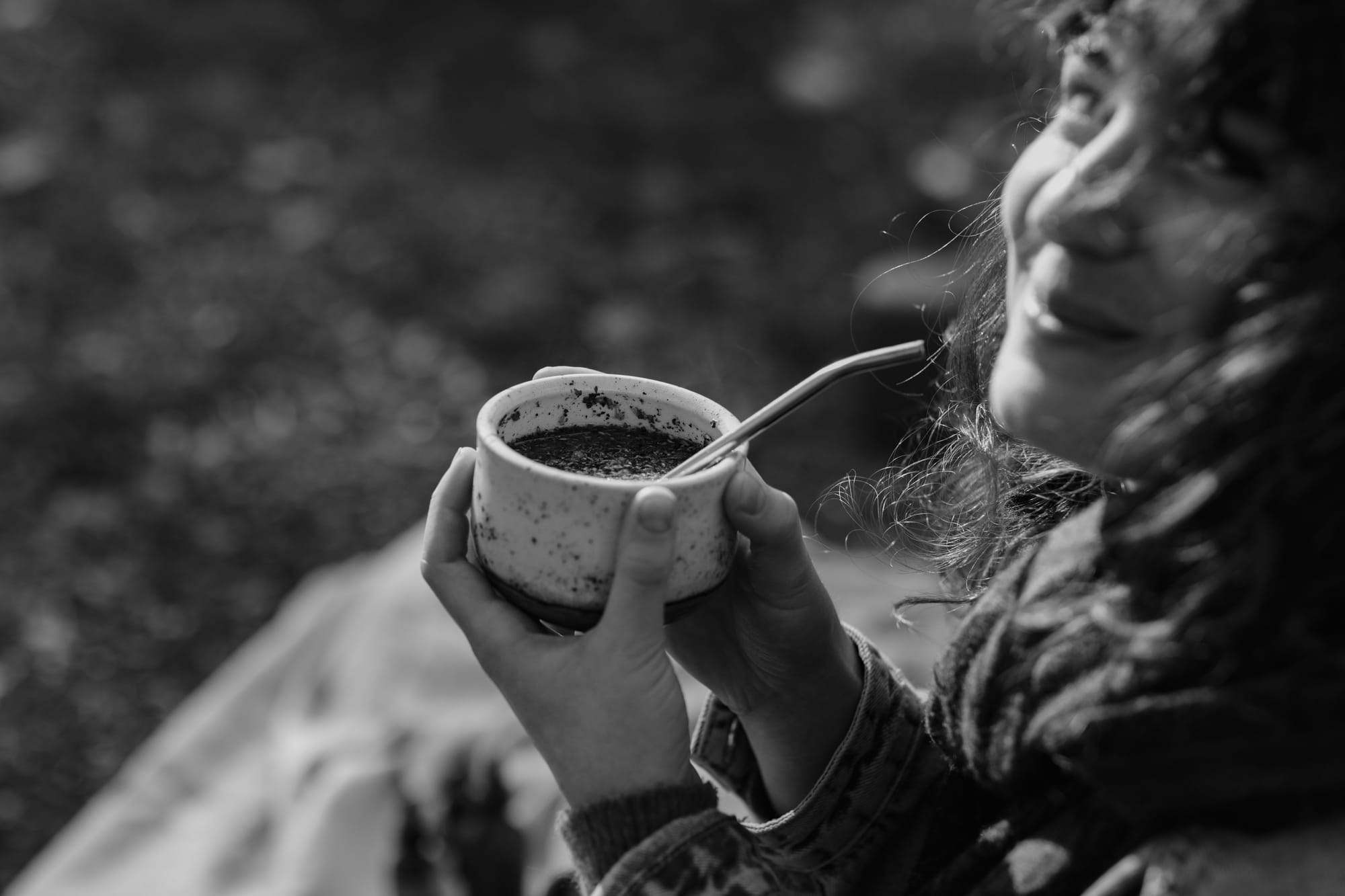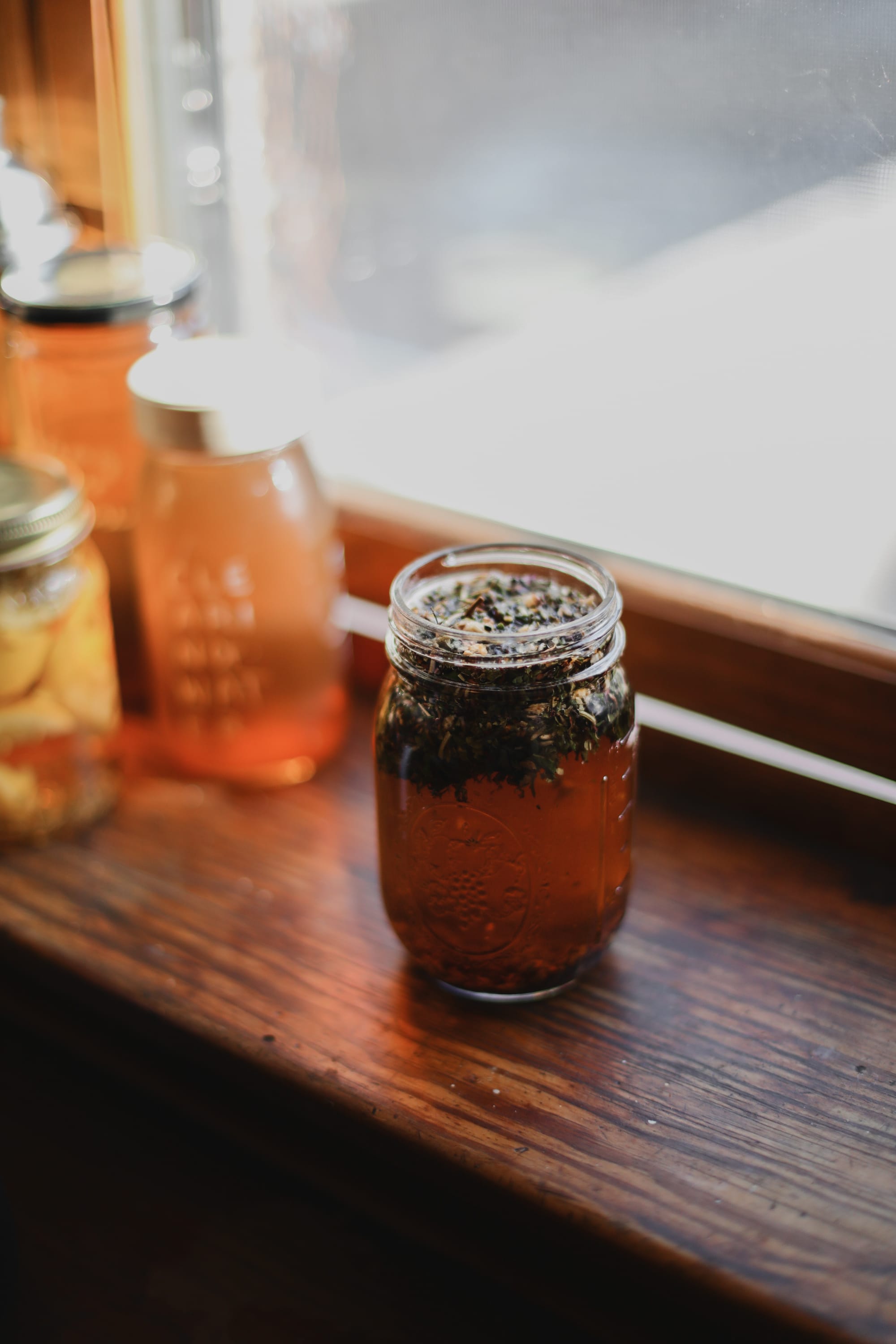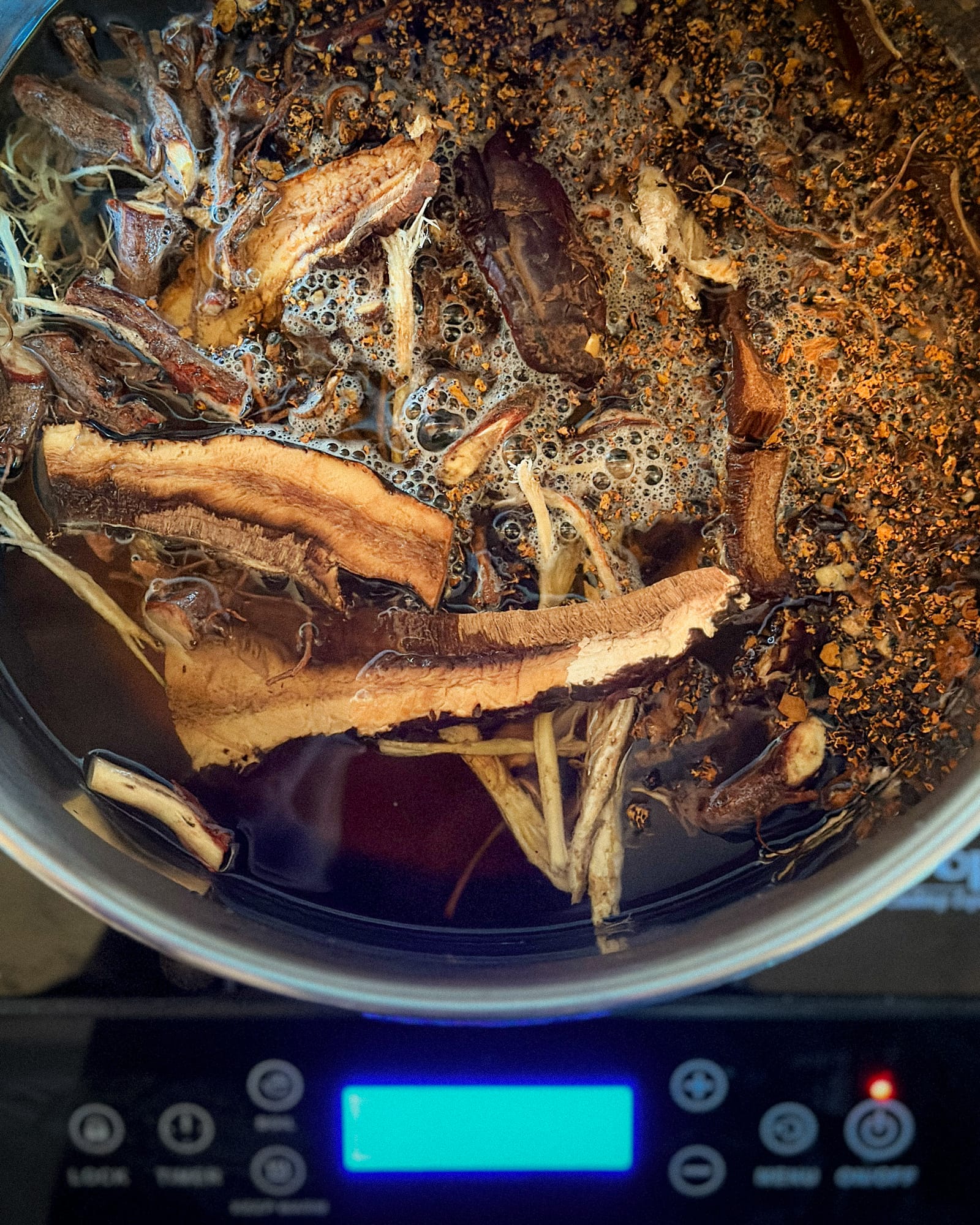Herbal Infusions & Decoctions: The Art of Making Tea

"Whatever the situation, whatever the race or creed,
Tea knows no segregation, no class nor pedigree
It knows no motivation, no sect nor organization,
It knows no one religion,
Nor political belief."
– The Kinks, Muswell Hillbillies, 1971
Conjuring plant magic with water
One of the primary pillars of my practice as an herbalist is simply just having some tea. Water, being “the universal solvent," is the perfect vehicle for plant extraction, and the practice of throwing wild plants in a pot of boiling water likely goes back to the discovery of fire.
Infusions are most strongly correlated with the water element, the element of winter and elder-hood. Water, like our elders, carries wisdom and holds memories. For this reason, I find that water is the best vehicle for plants to communicate their 'wisdom' and 'memory' to humans, teaching (reminding) our bodies how to heal and come back into balance.
Making a cup of tea is a simple way of reconnecting with the earth and the most ancient parts of ourself, while also being one of the easiest ways to cast a spell. When you prepare a cup of tea, you are practicing water magic, but also bringing together all elements in a slow act of meditative bliss. In the tea ceremony, fire heats water, which will eventually be poured over the herbs (earth) who then gives off a sensuous aroma and steam (air). We could then say the creative act (the spell itself) might be the ether, out of which each element comes together to create the potion before you.
The integration of elements is guided by our intuitive senses. Most home and folk herbalism is guided by intuition. In almost all realms of medicine making, aside from tinctures, I don’t often measure out herbs by weight, unless I am formulating for a client. But, I used to! And I think it’s important to start out weighing herbs when you make your teas, decoctions, infusions, syrups, what have you, because you get a sense of the density of certain herbs, how much a pinch or a handful of herbs actually translates to, and will hone your ‘eyeballing’ skills.
In addition to being a pillar of any home herbalist’s daily practice, making herbal infusions is a valuable way to learn the properties and personalities of different herbs. You start with a couple herbs on your shelf: maybe chamomile, lemon balm, & spearmint. Herbs you can grow in your garden or in your window planter. You get to know the herbs one at a time: their personalities, their virtues, their tastes, their smells, their feel on your fingers when you throw them in the jar. Then together: how their flavors swirl and play in the water together. You begin to learn the ‘energetics’ of herbs intuitively.
Then, maybe you throw more herbs into the mix. Perhaps you start making yourself a weekly tea blend at the beginning of the week. And Monday becomes a day to look forward to because you begin the week by paying deep attention to what your body needs.
Nurturing overall well-being
This brings us to yet another benefit of preparing tea... nurturing physiological and psychological well-being.
Consider this: over the course of several centuries, the Western diet has transformed radically as a result of industrial food production and factory farming to exclude many important trace minerals and nutrients that just aren't present in the processed foods, and tamed fruits/veggies available to us. Eating wild foods is one solution, but may not always be accessible for some people.

A good middle ground is to integrate a daily cup of herbal tea to provide those missing nutrients and minerals excluded from our habitual diet.
Herbalist Maria Noël Groves also offers this from her wonderful book, Body into Balance:
"Many of the herbs that benefit our nervous system – particularly the relaxing ones – are highly aromatic, so that a cup of tea provides not only the healing constituents you swallow but also the vapors you inhale. For these reasons, a daily tea ritual is one of the best ways to allow herbs to multitask and help you feel better. The simple act of making and drinking tea is an affirmation that you are taking care of yourself and that plants have the power to heal."
Making herbal infusions is the sensuous core of the radical potential of everyday herbalism. It is at once a meditation, a ritual, a love letter to your body, a rebellion against the busyness of our culture, and an ever unfolding practice of self-care.
In short, the simple process of making oneself a cup of tea can evoke the entirety of the cosmos and the potential of the herbs of healing to be reawakened, in a simple act mindfulness and preparation.
Making Tea
Although making a cup of tea (a.k.a. an 'herbal infusion') might seem like a lot of work at first, it becomes easier and something to look forward to the more you do it.
The one thing about water is that it is not a very good preservative. This is because of the role it plays in our environment: water helps things dissolve and break down. It encourages oxidation and bacterial growth that help with breakdown to get the nutrients back into the grand scheme of nature. The decay of the plants, animals and fungi that create the soil in which new things grow is made possible because water doesn’t act as a preservative.
Simply put, when using water as your solvent, you have to make a new cup or pot of tea daily, as harmful bacteria can begin growing in it. I give a batch of tea about two days in the fridge. But it never lasts that long, because I drink it. So really the only drawback I see is that I have to incorporate this meditative structure into my daily routine, which is fine by me (although for others, they might need some convincing).
For teas, infusions and decoctions, dried herbs are used. This is because when the plant dries (and again when hot water is added), its cell walls rupture and make for much more efficient extraction. Although, I often infuse fresh herbs when I’m camping or backpacking, or wandering a friend's garden might throw a sprig of fresh holy basil in my water bottle. Do dried if you can, fresh if you can’t (the only exception here being ginger, in my opinion).
That said, if you use fresh, you gotta use a lot more herb as the constituents aren’t as concentrated as in dried herbs.
infusions - (for fresh or dried herbs)
The simplest method for preparing an herbal infusion:
Steep some amount of herb in some amount of water for some amount of time. Strain and enjoy.
How to prepare an herbal infusion:
- Choose your herb or loose leaf herbal blend.
- Bring water to a boil.
- Measure out herbs in a teapot or mason jar.
- I tend to use a 32 oz / quart mason jar
- Pour the just boiled water over the herbs and quickly cover to preserve the potent volatile oil content.
- Allow to steep anywhere from five minutes to overnight, depending on the desired strength of the infusion.
- We usually steep our teas for at least 20-40 minutes.
- Strain and enjoy!

Some tips:
- If using a mason jar, fill the jar about ⅓ of the way for good strength infusion, using less for denser herbs and more for lighter, fluffier herbs.
- If you want to be more precise:
- For a standard infusion, use 1 tbsp (5-6g) herb to 8 ounces water.
- For a 32 oz mason jar, use 1/4 cup (24-28g) herb and fill to the top with water.
- When straining, a fine-mesh tea strainer is a go-to tool, but I also use bombillas (straining straws traditionally used for Yerba Mate) to sip right out of the jar we infused the herbs in.
- When the jar cools down and can be safely handled, you know you’ve got a strong infusion :)
variation: nourishing infusions
Same method as above, but with more herb and for a longer time, roughly following the guidelines in the table below:
| Plant Part | Preparation Ratio | Infusion Time |
|---|---|---|
| Roots & Barks | 1 ounce dried herb : 1 pint of water | 8 hours |
| Leaves | 1 ounce dried herb : 1 quart of water | 4 - 12 hours |
| Flowers | 1 ounce dried herb : 1 quart of water | 20 minutes - 2 hours |
| Seeds & Berries | 1 ounce dried herb : 1 pint of water | 30 minutes |
I like to make nourishing infusions before bed, left on the countertop, and enjoy throughout the next day, rather than making them in the morning and having to wait hours and hours to drink some. I also like to make nourishing infusions around dinner time, and by the time I go to bed, tighten the lid and stick it in the fridge for a strongly infused cold brew tea the next morning.
The boiling water and long extraction time is ideal for extracting minerals and nutrients from herbs such as Nettle, Oatstraw, Red Clover, and other nutrient rich “food herbs”. I wouldn’t recommend this method for more overtly ‘medicinal’ herbs, and probably not potent herbs like cayenne. As you experiment with different herbs you will notice which herbs are suitable for this method and which prefer a much shorter infusion time. I won’t give anything away though.
Michigan Herbalist jim mcdonald offers this bit of advice:
It’s worth mentioning that you needn’t use boiling water to extract the nutrients from “food herbs” such as those mentioned above. Michigan Herbalist Joyce Wardwell told me once that even warm or cool water will extract minerals via passive diffusion. She suggests steeping your herbs in cool water overnight then heating the tea up to sipping temperature the next morning. This will provide you with the nutrients provided by using boiling water, but less of the bitter, astringent tannins found in some herbs. The only difference in this process is that the herbs should be suspended at the top of whatever vessel you’re infusing in. As the water takes up minerals from the herbs, it becomes heavier and sinks to the bottom of the vessel, and the unladen water rises. This creates a “current” by which the mineral content of the herbs can be thoroughly extracted.
decoctions
Ideally suited for dried or fresh roots, barks, berries, seeds and mushrooms, i.e. the harder, woodier, or denser herbs that need a steady application of heat to more thoroughly break down the cell walls of the plant and extract its virtues.
How to prepare an herbal decoction:
Add 1 ounce of herb to a quart of cool/room temp water. Slowly bring to a boil, then simmer to reduce the volume to by about half. Strain, cool & drink smaller amounts (~4oz) several times throughout the course of a day.
This method is not recommended if you are desiring the aromatic qualities of certain herbs, as the long simmering time will let off all the volatile oils you are desiring. A nourishing infusion or regular infusion might be better suited here.
You are also welcome to combine a long-simmered decoction with a shorter infusion of the herb to combine medicinal virtues.

Soups, Stocks, and Broths
If you think about it, these are really decoctions too! With different combinations of herbs and spices, and perhaps some other unique plant combinations mixed in, like the classic mirepoix (carrot, celery, onion). I include this here to remind you that when making broths, throwing in nutritive roots and herbs that are suitable for long simmering times is an excellent addition. Some of my favorites to add to a classic stock are turkey tail mushrooms, shiitake mushroom, maitake mushroom, oat straw, nettle, astragalus, or calendula (in addition to the classics: garlic, sage, rosemary, thyme, parsley, leeks, and of course, your mirepoix). Lastly, adding a touch of apple cider vinegar to a broth helps to extract more mineral content from the herbs and vegetables you are using.
cold infusions
Ideally suited for highly mucilaginous herbs like marshmallow root. While you will still get mucilaginous qualities if infused with hot water, cold water is actually a better solvent than hot for such plants.
How to prepare a cold infusion:
Blend herbs in a mason jar filled with cool water, and let sit a few hours or overnight. Strain, drink, and savor the goo.
Note that this infusion will yield a somewhat goopy consistency that can range between a thick syrup and egg whites. These herbs tend to be called for in working with dried out tissues with inflammation present, and can be incredibly soothing. This applies to tissues along the GI tract, and on the skin as well. Once you make a cold infusion of marshmallow root, feel the consistency and you’ll understand why. Note that some commercially available marshmallow root and other demulcents like slippery elm might vary in terms of the mucilagenousness. If you cold infuse marshmallow root overnight, and it’s not goopy, unfortunately, it’s not very helpful and you might want to source from somewhere else.
Variation: ‘Icing’
While you can do this with really any infusion/herb, I’m putting it under the cold infusion category because I most often do this with a cold infusion of marshmallow root, which I then divide up into an ice cube tray and freeze.
Once frozen, you can pop a couple cubes out to add to other beverages for a demulcent boost.
You can also–and this is where ‘icing’ comes in–pop a cube of frozen marshmallow root cold infusion and rub it on your face or other particularly inflamed area of skin as needed. There are benefits to using just ice alone, but adding some herbs to the equation couldn’t hurt either! Ice helps to drain lymph where there is accumulation so icing can help reduce puffiness, tone the tissues, reduce redness and swelling, and brighten one’s complexion.
sun teas / moon teas
Similar to a cold infusion, the only difference is in placing the steeping jar out in the sun throughout the day to let the sun’s rays infuse its magic into your tea. The gentle warmth upon the glass raises the temperature, and the rest is simply magic. Great for yard work, gardenwork, any kind of daytime work where the sun is high and a gentle sun-drenched infusion will quench your thirst and cool you off.
For the lunarly inclined, let your herbs and water bask in the mysterious glow of the passing moon, then enjoy early the next morning as you reflect and wander back through your dreamscape from the night before. Moon teas are quite subtle, but their gentle energies are highly resonant with those engaging in dreamwork, shadow-work, active imagination, and other meditative and spiritual practices engaging the unconscious aspects of Self. Try it out one night and let the energies guide you where the day spirits never could.


Member discussion